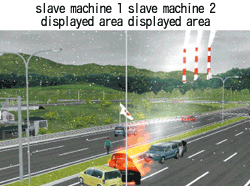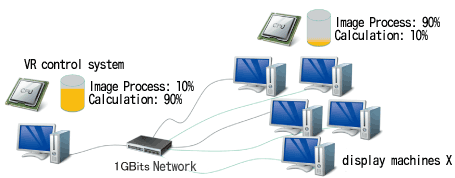
| Large scale multi VR |
The standard feature of the current UC-win/Road allows 4 channel display per PC.
FORUM8 is currently developing UC-win/Road cluster system to increase the number of display channels. This system can synchronize multiple PCs and project images to multiple monitors. Increased number of display channels lead to more effective immersion because of the enlarged projection area. The system will be ideal for simulators and conference rooms with 360-degrees cylindrical screen, and control room simulations.
- Easy set up and operation
- Flexible system with no limitations to the number and configuration of clustered PCs
- All functions of UC-win/Road can be used on clustered configuratios
- Improved performance on clustered system compared with single PC syste
- A variety of simulations are possible in this multipurpose system which has all elements synchronized
 |
Multiple PCs are connected via LAN, and one PC calculates the simulation. The calculation results are sent to the other PCs, which then process the images to display. In this system, the machine that calculates the simulation is called "the server" and the machines that receive the calculation results and process the images are called "slave machines". The calculation and processing of images are performed as follows.
- Simulation is calculated once for each frame
- After each calculation, the data required is sent to the slave machines
- While the slave machines process these images, the server calculates more data for the next frame
- The server will send the data for the next one frame, if the calculation takes less time than the time it takes for the slave machines to process the image.
This optimization minimizes problems caused by data sending/receiving time. Multicast IP is utilized to send data to the slave machines, so that it minimizes the work load at the server and on the network. - After image processing finishes, the server will perform the next calculation and data transmission.
 |
In the cluster system, one server machine calculates the simulation and the slave machines are used solely to process images. Because of the distributed workload, the performance of the system is improved. The previous versions of UC-win/Road processed all the calculations except for the traffic in a single thread, but for this multiple display channel function, the calculation and the processing had to be performed independently. As a result of optimized use of multi CPU and multi-core CPU on the standard configuration of the UC-win/Road, we can see the improved performance of 3D trees, flags, clothes, fire and smoke and the animation of MD3 characters.
The data, which server sends to the slave machines, are the information and attributes of moving elements. Each slave machine processes images after receiving data to update the 3D space. When visualizing 3D trees, flags, rain and snow, the processing becomes more complicated, thus, the data becomes larger, and therefore, high speed data transmission over a network becomes nearly impossible. Hence, to process of these objects, server sends minimum parameters for the calculation and the slave machines processes the calculation.
As the functions for the cluster system was added with the standard version of UC-win/Road as the basis, the system has all the features of the standard UC-win/Road. To minimize operations on the slave machines, all the operations except for the initial settings can be done on the server machine. At the time of simulation, operation is done by server machine and visualization is done by slave machines.
The cluster system is operable only when using the following functions with following settings.
| Initial setting of slaves | slave machine name, network address of server |
| Server | Area displayed by slave machines |
| Disconnect slave machines | |
| Restart, shut down and data import of slave machines | |
| Switching to server/ standard mode or automatic start of server mode | |
| Simulation start/ end |
We measured the level of performance to check the validity of this system. We found that its performance improved, in comparison with the standard UC-win/Road system, and that the number of clustered PC does not affect the performance. In addition, by comparing 4-channel clustered configuration with the standard configuration, we saw the improvement of 140%. By comparing 15 slave machines and standard 1 channel, we saw the improvement of 20 %.
 |
The basic function of the cluster system is to realize synchronized display of one virtual reality environment on multiple PCs. The function improves the sense of immersion and the system is applicable to other usage than the improved sense of immersion. For example, single image of VR is broadcasted to a number of people taking part in driving simulation in the same VR environment is done, taking the interaction with other people into account.
(Up&Coming 2010 Early spring issue)
